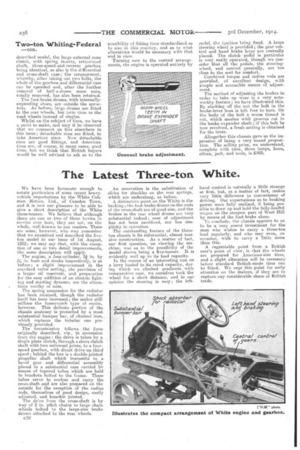The New Two-ton Whiting-Federal.
Page 13

Page 14

If you've noticed an error in this article please click here to report it so we can fix it.
Our readers will probably remember a description which we gave, in the early Part of this year, of quite a good type of thirty-hundredweight. American chassis, the Whiting-Federal, hamlled in this country by Whiting, Ltd., of 334-340, Eueton Road. We have pleasure in supplementing the information then supplied by a few notes descriptive of a twotonner emanating from the same source.
This model is on the same lines as the smaller one, several of the units are, in' fact, identical. We shall therefore content ourselves by noting the points of difference.
The engine, though in design identical -with its predecessor, is a little larger, being 44 ins. -by 5J ins, bore and stroke respectively, governed so as to run at a maximum speed of 1000 r.p.m., this corresponding to a road-speed. of 15 miles per hour. The admirable three-point suspension of tlas engine is a noteworthy feature.
The power unit is a remarkably clean example of design ; it is known in the States as a Continental engine and is of the monobloc type. The lubrication is by splash from trough, wherein the oil is maintained at a constant .„1-vel by a pump. A plunger in a sight glass above the crankcase indicates the quantity of oil contained.
The radiator has been improved, bot,h in appearance and construction, its capacity has also been considerably increased, and a very adequate hinged filler cap is now provided. The honeycomb
type of cooler has been discarded, and one of vertical tubes substituted. The spring suspension of this unit is retained.
Behind the engine the transmission is very little different to the previously, described model, the large external cone clutch, with spring inserts, articulated shaft, three-speed-and-reverse gearbox being identical, as also is the differential and cress-shaft case; the arrangement, whereby, after taking out two bolts, the whole of the gearbox and differential case can be upended and, after the further removal of half-a-do4en more nuts, totally removed, has also been retained_ The foot-brake drums, with internallyexpanding shoes, are outside the sprockets. As before, large drums are fitted to the rear wheels, but twin tires to the road wheels incotead of singles. Whilst on the subject of tires, we have a point to make, and may it be observed that we comment on this elsewhere in this issue ; detachable rhns are fitted, to take American sizes. Now detachable rims are good fittings, and American tires are, of course, in many cases, good tires, but we think that British buyers would be well advised to ask as to the -possibility of fitting tires standardized as to size in this country, and as to what alterations would be necessary with that end in view.
Turning now to the control arrangements, the engine is operated entirely by pedal, the ignition being fixed. A large steering wheel is provided; the gear control and hand brake lever are centrally placed. The clutch • pedal in particular is very easily operated, though we consider that all the pedals, the steeringwheel, and control generally, are too close to the seat for comfort.
Combined torque and radius rods are provided, of excellent design, with simple and accessible means of adjustment.
The method of adjusting the brakes in order to take up wear is a very noteworthy feature ; we have illustrated this. By slacking off the nut the bolt in the brake-lever boss is left free to turn. On the body of the -bolt a worm thread is cut, which meshes with grooves cut in the brake expander shaft ; if this bolt be now revolved, a fresh setting is obtained for the lever.
Altogether this chassis gave us the impression of being a very sound proposition. The selling price, we understand, complete with tires, three lamps, horn, oilcan, jack, and tools, is 495.




















